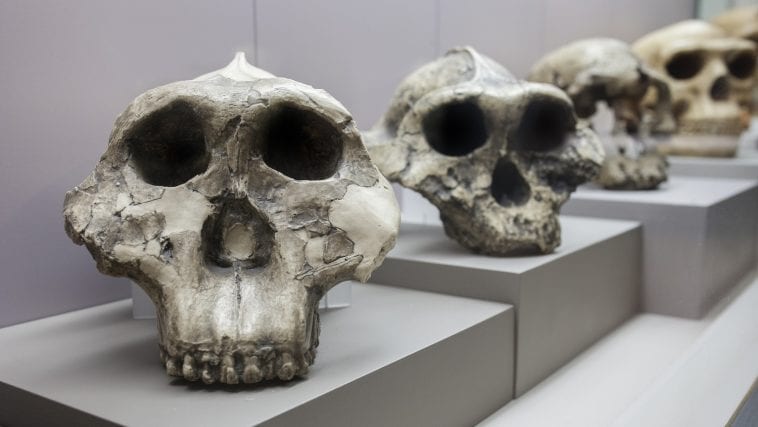[Originally published as the second part of To a theologian on the subject of hominins]
Besides the more obviously human or not fossils, there are the less certain hominins where the evidence is incomplete, and that brings me to my next big point:
Even though these hominins are very interesting and even challenging, there is a lot we don’t know.
Sometimes when I hear theologians make reference to hominins, they act as if everything is settled, as if “all the evidence” supports whatever conclusion they want to argue for, whether creationist or evolutionist. The more I study anthropology, the less comfortable I become with certainty. There is just so much that we don’t know, and the science is changing fast with spectacular new discoveries every five years or so.
We can see this uncertainty in a couple of different ways.
Lack of Evidence
One way is in the paucity of evidence we have for certain hominins. For example,
- In southeast Asia, we have evidence of small-bodied hominins living in modern Indonesia and the Philippines.
- On the Flores, we have a decent amount of evidence in the form of a partial skeleton and stone tools from the Liang Bua cave.
- At a nearby site on the same island, we have teeth and a jawbone that are of a similar size but different from the Liang Bua hominins.
- In the Philippines, we have an ancient and elaborate rhinoceros butchery site and more recent small teeth and bones that evidence yet a third (and possibly fourth) type of small hominin. (See here for more on these discoveries.)
Right now, that’s all the evidence we have.
It certainly looks like humans have been in southeast Asia for a very long time, but we really don’t know who killed that rhino or how these hominins may or may not be related to us. There’s just not enough evidence to be sure about much (for comparison, there’s >400 Neandertal individuals known from across Europe and Asia, and even from the Holy Land).
My own evaluation of the southeast Asian hominins puts them in the human category, but obviously there’s much we don’t know and my assessment could be wrong.
Rethinking Assumptions
The second big way we see uncertainty play out in hominin research is the regular and sometimes revolutionary discoveries that make us rethink past assumptions.
Some creationists will seize on these discoveries and conclude that evolutionists are just making everything up and you can’t trust anything. I don’t see anything nefarious in these revolutionary discoveries.
This is just how science works: We scientists make conclusions based on the evidence at hand, and then new evidence comes to light that makes us revise our conclusions. It’s how rationality works. When we learn something new, we might change our minds.
The revolutionary aspect of some discoveries has almost become a trope in science. For example, opinions about Neandertals in the early twentieth century perceived them as animalistic brutes that were barely more advanced than gorillas. Ralph Solecki’s discoveries at Shanidar cave made people rethink things. There’s still a lot of discussion of just how “advanced” Neandertals were, but I can’t think of anyone who looks at Neandertals as no more clever than gorillas.
More recently, discoveries have challenged the sort of linear view of human evolution that assumed (based on ecology) that there could only be one hominin species alive at any one time. If there were two hominin species alive at the same time, they would compete, and one species would drive the other to extinction.
Genetic evidence of interbreeding with Neandertals indicate that Neandertals and humans did not always fight to the death when they met. The discoveries at Flores and Rising Star (Homo naledi) both reveal hominins different from Homo sapiens that exhibit impressively human-like behaviors (sea faring in the case of the Philippines, and burial of the dead in the case of H. naledi) at the same time on the conventional timescale that Homo sapiens existed or could have existed.
Enigmatic Evidence
The third way we see the uncertainty and incompleteness of hominin evidence is with discoveries no one is quite sure what to make of. Ancient DNA studies about a decade ago uncovered an entire lost group of hominins with big molars that we call Denisovans. We still don’t know much about their appearance, and we did not expect them from studies of the fossil record.
Over in the Republic of Georgia, scientists have found five different skulls at a site called Dmanisi, and experts are still debating whether they belong to a single, variable species or represent more than one species.
Over the years, in my many interactions with theologians and Bible teachers, I’ve heard the advice that one shouldn’t make a big doctrine out of a single verse in the Bible. That sort of thing leads to error. Instead, we should emphasize those parts of scripture that are clear and repeated to infer important doctrines.
Same goes for anthropology. Parts of the record, I think, are very clear, but other parts are very murky and uncertain. Don’t let scientists or other theologians bully you into thinking that it’s all very obvious and consistent and that you must make a firm conclusion right now.
As I think about different “evolutionary creationists” that I know, there seems to me to be a kind of discomfort about all this scientific uncertainty. I definitely see some voices in the debate zealously defending a view of Genesis that denies that it has anything to say about historical reality. They seem to want to construct a theology that is wholly impervious to science, a theology that will never change no matter what scientists have to say. Needless to say, I think this is tragically wrong.
It’s Good to have Uncertainty
To me, the uncertainty of anthropology is beautiful in two important ways.
First, it keeps us humble, because we’re prone to make mistakes, and those mistakes are constantly coming to light.
Second, it’s exciting. What will we discover next? What will that tell us about God and his creation? It’s a thrill to see new works of God finally come to light after all these years.
But more importantly, it’s true to our existence in both theology and science. I would never dream of claiming that I know all there is to know about God and that there are no unanswered theological questions. Why would I make that sort of claim about anthropology?
Of course, working through all these questions leads to other questions that start to get into even more difficult details. We can hardly talk about hominins without thinking about the age of these fossils and how those ages might relate to the events described in the Bible.
Likewise, beyond just hominins, we also have many questions raised by archaeology. Places like Stonehenge or Gobekli Tepe and discoveries like Otzi the Ice Man also pose difficult questions of how to reconcile this evidence with Scripture. Then on the scriptural side, I find it rather surprising how theologians and biblical archaeologists see Babel as a strictly local event, and I wonder if that conclusion is driven by the science or by the text.
How should we understand the Flood? Just a legend? Legend based on fact (like the so-called “Black Sea Flood”)? Or is it a historical record of something even bigger?
Remember Our Limitations
I guess my advice is to be humble and recognize the difficulties for what they are. Don’t be so humble as to seriously entertain the improbable and unlikely, and that goes for all sides. I think the constant calls of “fraud” every time a new discovery is announced or the reassurance that human evolution poses no difficulty for the Christian faith are equally unbelievable. On the other hand, countering arrogance and overconfidence with overconfidence will very likely lead you down the wrong path.
To sum up, my main points are these:
- Be careful how you define terms like hominin or human. Everyone seems to think we all know what they mean, but I find too often terminology is more a hindrance than a help. Be precise.
- The answers you seek are not found in a simple dichotomy of hominins are or are not human. Reality is more complicated.
- The science of anthropology is full of uncertainties, despite what some anthropologists (and theologians) want to tell you. Don’t be deceived into thinking that everything is settled, and it’s just a matter of fitting theology to this unassailable science. It’s not remotely so simplistic.
I hope and pray these ideas give you some guidance as you explore the issues on your own.
If you want to dig deeper, here are some papers you might consult:
- A review of Jack Collins’s book where I raise a lot of these same questions.
- Here’s a short essay from Gary Phillips that discusses how we ought to react to hominin discoveries.







